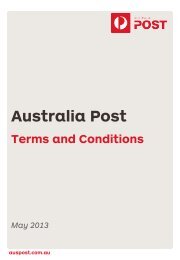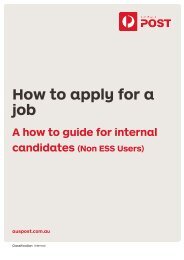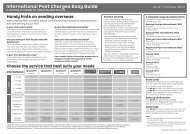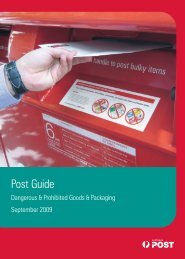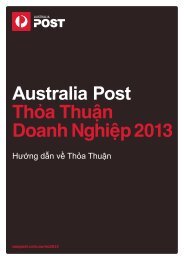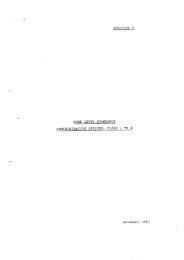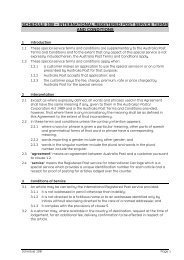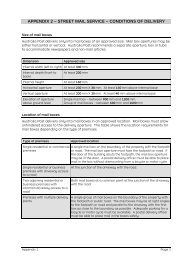2009-10 Annual Report - Australia Post
2009-10 Annual Report - Australia Post
2009-10 Annual Report - Australia Post
You also want an ePaper? Increase the reach of your titles
YUMPU automatically turns print PDFs into web optimized ePapers that Google loves.
notes to And ForminG PArt oF the FinAnCiAl rePort For the year ended 30 June 20<strong>10</strong><br />
When the recoverable amount of the cash-generating unit (group of<br />
cash-generating units) is less than the carrying amount, an impairment<br />
loss is recognised. When goodwill forms part of a cash-generating unit<br />
(group of cash-generating units) and an operation within that unit is<br />
disposed of, the goodwill associated with the operation disposed of is<br />
included in the carrying amount of the operation when determining the<br />
gain or loss on disposal of the operation. Goodwill disposed of in this<br />
manner is measured based on the relative values of the operation<br />
disposed of and the portion of the cash-generating unit retained.<br />
impairment losses recognised for goodwill are not subsequently reversed.<br />
(y) intangible assets<br />
intangible assets acquired separately or in a business combination are<br />
initially measured at cost. the cost of an intangible asset acquired in<br />
a business combination is its fair value as at the date of acquisition.<br />
Following initial recognition, intangible assets are carried at cost less<br />
any accumulated amortisation and any accumulated impairment losses.<br />
internally generated intangible assets, excluding capitalised<br />
development costs, are not capitalised and expenditure is recognised<br />
in profit and loss in the year in which the expenditure is incurred.<br />
the useful lives of intangible assets are assessed to be either finite<br />
or indefinite. intangible assets with finite lives are amortised over their<br />
useful life and tested for impairment whenever there is an indication that<br />
the intangible asset may be impaired. the amortisation period and the<br />
amortisation method for an intangible asset with a finite useful life are<br />
reviewed at least at each financial year-end. changes in the expected<br />
useful life or the expected pattern of consumption of future economic<br />
benefits embodied in the asset are accounted for prospectively by<br />
changing the amortisation period or method, as appropriate, which is a<br />
change in accounting estimate. the amortisation expense on intangible<br />
assets with finite lives is recognised in profit or loss in the expense<br />
category consistent with the function of the intangible asset.<br />
intangible assets with indefinite useful lives are tested for impairment<br />
annually either individually or at the cash-generating unit level consistent<br />
with the methodology outlined for goodwill above. such intangibles are<br />
not amortised. the useful life of an intangible asset with an indefinite life<br />
is reviewed each reporting period to determine whether indefinite life<br />
assessment continues to be supportable. if not, the change in the useful<br />
life assessment from indefinite to finite is accounted for as a change in<br />
an accounting estimate and is thus accounted for on a prospective basis.<br />
computer software is carried at cost and is amortised on a straight-line<br />
basis over its anticipated useful life, being four to eight years.<br />
research and development costs<br />
research costs are expensed as incurred. an intangible asset arising<br />
from development expenditure on an internal project is recognised only<br />
when the group can demonstrate the technical feasibility of completing<br />
the intangible asset so that it will be available for use or sale, its intention<br />
to complete and its ability to use or sell the asset, how the asset will<br />
generate future economic benefits, the availability of resources to<br />
complete the development and the ability to measure reliably the<br />
expenditure attributable to the intangible asset during its development.<br />
Following the initial recognition of the development expenditure, the<br />
cost model is applied requiring the asset to be carried at cost less any<br />
accumulated amortisation and accumulated impairment losses. any<br />
expenditure so capitalised is amortised over the period of expected<br />
benefits from the related project.<br />
56<br />
AustrAliA <strong>Post</strong> AnnuAl rePort <strong>2009</strong>–<strong>10</strong> | Financial and statutory reports<br />
the carrying value of an intangible asset arising from development<br />
expenditure is tested for impairment annually when the asset is not yet<br />
available for use or more frequently when an indication of impairment<br />
arises during the reporting period.<br />
Gains or losses arising from derecognition of an intangible asset are<br />
measured as the difference between the net disposal proceeds and the<br />
carrying amount of the asset and are recognised in profit or loss when<br />
the asset is derecognised.<br />
(z) impairment of non-financial assets (other than goodwill<br />
and indefinite life intangibles)<br />
the group assesses at each reporting date whether there is an<br />
indication that an asset may be impaired. if any such indication exists<br />
or when annual impairment testing for an asset is required, the group<br />
makes an estimate of the asset’s recoverable amount. an asset’s<br />
recoverable amount is the higher of its fair value less costs to sell and<br />
its value in use and is determined for an individual asset, unless the<br />
asset does not generate cash inflows that are largely independent of<br />
those from other assets or groups of assets and the asset’s value in use<br />
cannot be estimated to be close to its fair value. in such cases the asset<br />
is tested for impairment as part of the cash-generating unit to which it<br />
belongs. When the carrying amount of an asset or cash-generating unit<br />
exceeds its recoverable amount, the asset or cash-generating unit is<br />
considered impaired and is written down to its recoverable amount.<br />
in assessing value in use, the estimated future cashflows are discounted<br />
to their present value using a pre-tax discount rate that reflects current<br />
market assessments of the time value of money and the risks specific<br />
to the asset. impairment losses relating to continuing operations are<br />
recognised in those expense categories consistent with the function<br />
of the impaired asset unless the asset is carried at revalued amount<br />
(in which case the impairment loss is treated as a revaluation decrease).<br />
an assessment is also made at each reporting date as to whether<br />
there is any indication that previously recognised impairment losses<br />
may no longer exist or may have decreased. if such indication exists, the<br />
recoverable amount is estimated. a previously recognised impairment<br />
loss is reversed only if there has been a change in the estimates used<br />
to determine the asset’s recoverable amount since the last impairment<br />
loss was recognised. if that is the case, the carrying amount of the<br />
asset is increased to its recoverable amount. that increased amount<br />
cannot exceed the carrying amount that would have been determined,<br />
net of depreciation, had no impairment loss been recognised for the<br />
asset in prior years. such reversal is recognised in profit or loss, unless<br />
the asset is carried at a revalued amount, in which case the reversal is<br />
treated as a revaluation increase. after such a reversal, the depreciation<br />
charge is adjusted in future periods to allocate the asset’s revised<br />
carrying amount, less any residual value, on a systematic basis over<br />
its remaining useful life.<br />
(aa) trade and other payables<br />
trade and other payables are carried at amortised cost and due to their<br />
short-term nature they are not discounted. they represent liabilities for<br />
goods and services provided to the group before the end of the financial<br />
year that are unpaid and arise when the group becomes obliged to make<br />
future payments in respect of the purchase of these goods and services.




